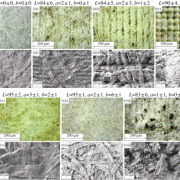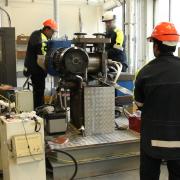Other sectors: we have completed projects on cement, paper and aluminium and think that the industrial equipment sector has particular potential for innovating to release a low material future.
The basic idea that making products with half as much material and using them for twice as long extends across the bulk materials as the key strategy for mitigating climate change. As with steel, the other energy intensive bulk materials processing industries (cement, plastic, aluminium and paper) have already pursued every possible energy efficiency measure with great diligence – for the same reason that energy costs are a significant component of their total costs, so they have every motivation to reduce them regardless of environmental concern.
Cement
Cement suffers the difficulty that it cannot be recycled – it takes around the same amount of energy to convert old cement into new cement is it does to make new cement from limestone, so there is no energy benefit in recycling. What’s sometimes called “concrete recycling” – crushing old concrete as a substitute for using aggregate in making new concrete has little if any energy benefit. The key then to reducing the emissions impact of cement is to use it efficiently – by choosing the best possible mix of cement to sand and stone and by shaping concrete components for maximum efficiency – and to use it for as long as possible. Having spent a lot of our time in the past 10 years exploring the potential to use steel more efficiently, it’s a priority for us to learn more about cement in our on-going work.
Paper
Paper can be recycled effectively, although the mechanical process of pulping old paper tends to shorten the fibres that give paper its strength, so paper recycling is generally a form of down-cycling. The idea of replacing paper with electronics has gained attention ever since the concept of the “paperless office” was introduced in the 1970’s. However, in reality, paper demand has gone up steadily since 1970, apart from the recent decline of paper use for newsprint, and it is difficult to evaluate the balance of environmental effects between using more electronic readers and less paper: it isn’t clear how much paper is really saved by such readers, and as they are replaced frequently as newer technologies make earlier readers obsolete, it is very difficult to give a clear picture of whether substituting electronics for paper has any environmental gain. A promising area we’ve worked on, and which led to the foundation of a spin-out company Reduse Ltd, is to remove toner print to allow direct paper re-use. This looks environmentally promising, but so far has been difficult to justify on costs, as the required laser is expensive.
Aluminium
Like steel, we can use half as much aluminium in many products and use them for twice as long. The aerospace industry is notoriously inefficient in using aluminium – its “buy to fly” ratio for metal can be as bad as 10:1 – although making aeroplanes is not a large fraction of total aluminium production. Making drinks cans and other packaging is a much bigger use of aluminium, and these products which have a very short lifespan and are difficult to collect for recycling could be replaced by lower impact alternatives. A large fraction of aluminium is used in construction, particularly in creating the cladding that forms the external surfaces of commercial buildings. At present this is poorly separated from other wastes when buidlings are demolished, and better handling of end-of-life building materials would allow much greater value to be maintained in these applications. We’ve also worked on the exciting possibility of recycling aluminium without melting it – by “solid-bonding.” This looks technologically attractive, although we haven’t yet found a key application. One promising area is in the efficient collection of swarf from machining centres – potentially much more value could be created from swarf, if the chips of each distinct aluminium alloy were collected and bonded together as part of the swarf handling system, maximising the potential for future recycling.
Plastic
Plastics are the most challenging material for us. By definition, plastic materials have tremendous variety – the attraction of plastic is that, through appropriate additives, it can be tailored in colour, texture, density, strength and other properties to exactly the application in which it is used – whether for packaging, pipes, clothing or coatings. Plastic can be recycled perfectly if it is perfectly segregated by composition, but the value of plastic recycling drops rapidly as the composition is less controlled. We still need to learn more about how best to reduce the impact of producing plastic production and a priority is to look at the high volume industrial uses of the material – which dwarf the highly political use of plastic in carrier bags, which although highly visible as litter, in reality were never more than a very small fraction of all plastic applications.
The main projects we have completed in this broad area of “other materials” are:


